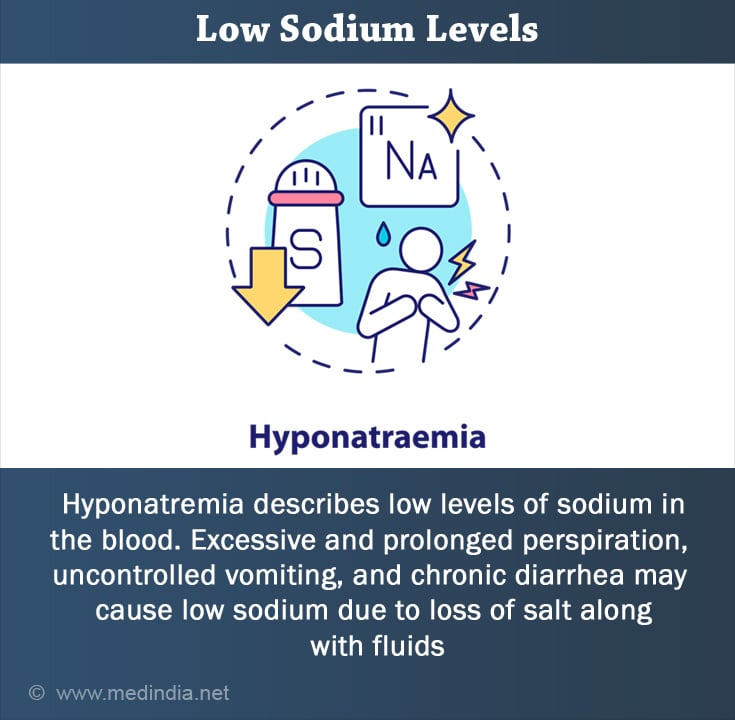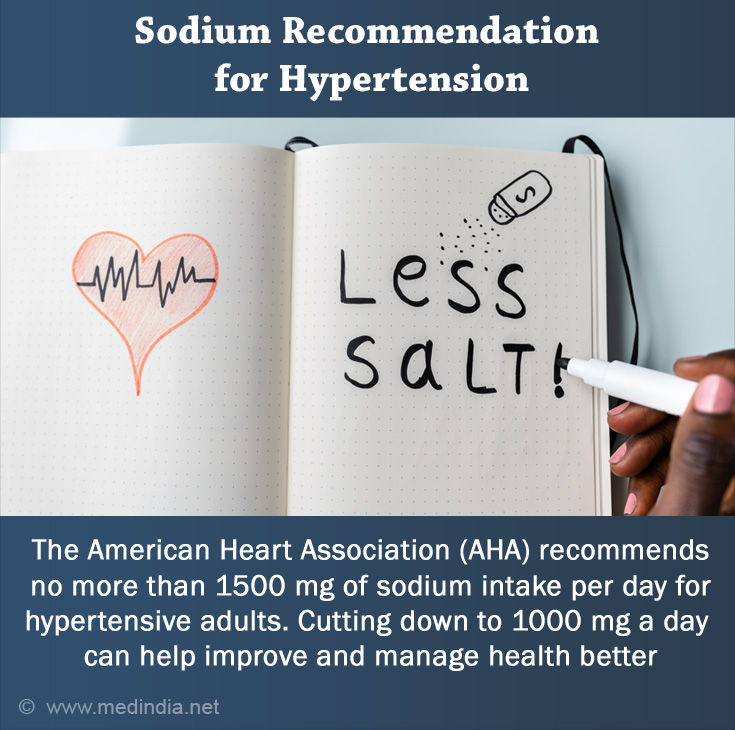- Sodium Intake and Health: What Should We Recommend Based on the Current Evidence? - (http://dx.doi.org/10.3390/nu13093232)
- Sodium - (https://doi.org/10.3945/an.113.005215)
- Salt and Sodium - (https://www.hsph.harvard.edu/nutritionsource/salt-and-sodium/)
- Sodium and Health - (https://www.cdc.gov/salt/)
- Guidelines for a Low Sodium Diet - (https://www.ucsfhealth.org/education/guidelines-for-a-low-sodium-diet)
- Guideline: sodium intake for adults and children - (https://www.who.int/publications/i/item/9789241504836)
- Sodium Content of Common Foods - (https://www.unitedregional.org/wp-content/uploads/2016/01/Sodium_Content.pdf)
- Sodium in Your Diet - (https://www.fda.gov/food/nutrition-education-resources-materials/sodium-your-diet)
- Reduce Salt - (https://eatrightindia.gov.in/reduce-salt.jsp)
- Kids and sodium: Serious risks, alarming realities - (https://www.mayoclinichealthsystem.org/hometown-health/speaking-of-health/kids-and-sodium-serious-risks-and- alarming-realities)
- Shaking the Salt Habit to Lower High Blood Pressure - (https://www.heart.org/en/health-topics/high-blood-pressure/changes-you-can-make-to-manage-high-blood- pressure/shaking-the-salt-habit-to-lower-high-blood-pressure)
What does Sodium do for the Body?
Sodium is an essential mineral needed in adequate amounts for the normal functioning of the body. The mineral is obtained from foods and drinks and is discharged primarily via sweat and urine. Sodium helps to maintain fluid and electrolyte balance, relax and contract muscles, transmit nerve impulses, and maintain optimal blood pressure. It also helps maintain extracellular fluid volume with its osmotic properties and transports substrates and nutrients through plasma membranes. The nutrient holds a sweet spot in human health, where high and low sodium levels reflect negative impacts(1✔ ✔Trusted Source
Sodium Intake and Health: What Should We Recommend Based on the Current Evidence?
Go to source, 2✔ ✔Trusted Source
Sodium
Go to source).
Salt and Sodium
Salt is the first ingredient that strikes when considering sodium intake. It should be noted that salt (scientifically called Sodium chloride) has sodium in abundance but is not the only food that contains sodium. Different varieties of salt contain different concentrations of sodium and may vary with brands as well. The sodium content (per teaspoon) of a few salt types are mentioned here: 2300 mg in iodized table salt, 1920 mg in Kosher salt (course), 1120 mg in diamond crystal Kosher salt, 2200 mg in pink Himalayan salt, 1560 mg in sea salt (crystal), and 1150 to 2200 mg in black salt(3✔ ✔Trusted Source
Salt and Sodium
Go to source).
Foods Naturally High in Sodium
Sodium naturally occurs in several foods, although plenty is added during preparation and processing. This does not include only the foods that taste salty, as there are some foods that may be a rich source of sodium and still not taste salty. Canned, processed, and convenience foods contain high levels of sodium, and about 70% of the sodium is consumed from such foods. The Centers for Disease Control and Prevention (CDC) has stated that about 40% of the sodium is consumed from the following sodium-rich foods: soups, chicken, cheese, savory snacks, tacos, burritos, cured and cold-cut meats, pizza, sandwiches, breads, and eggs(4✔ ✔Trusted Source
Sodium and Health
Go to source, 5✔ ✔Trusted Source
Guidelines for a Low Sodium Diet
Go to source).
The sodium content of some high-sodium foods is mentioned below(6✔ ✔Trusted Source
Guideline: sodium intake for adults and children
Go to source, 7✔ ✔Trusted Source
Sodium Content of Common Foods
Go to source) -
| Foods | Sodium content (mg / 100 g) |
| Soy sauce | 7000 |
| Snacks (like popcorn, cheese puffs, pretzels) | 1500 |
| Sauces and spreads | 1200 |
| Bacon | 1500 |
| Crabmeat, canned | 1000 |
| Mustard, prepared yellow | 1252 |
| Sausage (Bologna) | 1300 |
| Margarine | 987 |
| Processed vegetables | 600 |
| Processed fish | 400 |
| Cheese, hard | 800 |
| Cheese, soft | 400 |
Recommended Sodium Intake by Age
The general sodium intake recommendation for adults is 2,300 mg per day. However, an average Indian is known to consume about 11g of salt per day, which accounts for more than 4000 mg of sodium. For children, the recommendations include less than 1200 mg for 1-3 years, less than 1500 mg for 4-8 years, less than 1800 mg for 9-13 years, and 2300 mg for 14-18 years(8✔ ✔Trusted Source
Sodium in Your Diet
Go to source, 9✔ ✔Trusted Source
Reduce Salt
Go to source, 10✔ ✔Trusted Source
Kids and sodium: Serious risks, alarming realities
Go to source).
Sodium Deficiency
Sodium deficiency is not very common even when individuals follow a low-sodium diet due to the presence of added salt in commonly used food products. Hyponatremia describes low levels of sodium in the blood. A deficiency of sodium is common among individuals on long-term treatments that deplete the body of sodium. Excessive and prolonged perspiration, uncontrolled vomiting, and chronic diarrhea may cause low sodium due to loss of salt along with these fluids that are expelled from the body. Increased fluid intake may also turn down sodium levels in the blood and may be caused by heart failure, liver cirrhosis, or kidney failure(2✔ ✔Trusted Source
Sodium
Go to source, 3✔ ✔Trusted Source
Salt and Sodium
Go to source).

Sodium and Health
A high sodium diet makes the body hold on to more water in order to dilute the excess sodium, which in turn increases the volume of fluid around the cells and the volume of blood. An increase in blood volume raises the pressure on blood vessels and stiffens them, leading to high blood pressure (hypertension). High blood pressure causes the heart to work harder and makes the blood flow at a high force, hurting the arteries and organs such as the kidneys, brain, and nerves. Uncontrolled blood pressure may often lead to heart attacks, strokes, heart failure, kidney disease, and vision impairment.
High sodium intake has been known to impart effects on the immune system by experimental and clinical studies. Chronic consumption of high-sodium foods has indicated associations with a raised risk of chronic kidney diseases (CKD), osteoporosis, and gastric cancer. A study found that a high sodium intake of more than 4600 mg was associated with the progression of CKD, whereas a low sodium intake of less than 2300 mg had no significant impact. A high salt intake causes more calcium to be depleted from the body. Low calcium levels in the blood cause the bone to lose its calcium content, thereby leading to low bone density(2✔ ✔Trusted Source
Sodium
Go to source, 3✔ ✔Trusted Source
Salt and Sodium
Go to source).
Low Sodium Diet for Hypertension
The American Heart Association (AHA) recommends no more than 1500 mg of sodium intake per day for hypertensive adults. Cutting down to 1000 mg a day can help improve and manage health better. Below are a few tips while following a low-sodium diet,
- Choose foods low in sodium and less in salt.
- Read labels while purchasing processed, prepared, or pre-packed foods.
- Prefer foods without sauces.
- Prefer fresh fruits and vegetables to canned and frozen products.
- Choose unsalted nuts, seeds, lentils, soups, and broths.
- Ditch the table salt for alternatives like spices, herbs, and salt-free seasonings.
- When dining out request to prepare foods without salt(11✔ ✔Trusted Source
Shaking the Salt Habit to Lower High Blood Pressure
Go to source).
Randomized controlled trials have reported that moderate sodium restriction has shown significant reductions in blood pressure (BP) among adults with hypertension. Another study found that reducing dietary sodium levels in the DASH (Dietary Approach to Stop Hypertension) diet and in standard diet showed a positive impact on blood pressure(2✔ ✔Trusted Source
Sodium
Go to source, 3✔ ✔Trusted Source
Salt and Sodium
Go to source).

Low Sodium Alternatives
Below mentioned are foods from different food groups that pose a good alternative to include in low-sodium diets.
- Dairy products: Milk, yogurt, and low sodium cheeses
- Cereals: Bread without salted tops, rice and pasta without salt, low sodium tortilla, noodles, crackers, breadsticks, unsalted popcorn, chips, and pretzels
- Fruits and Vegetables: Low-sodium canned vegetables, juices, sauces, and fresh fruits and vegetables
- Animal products and Nuts: Fresh lamb, poultry, and fish, eggs, low sodium canned fish, and unsalted nuts(5✔ ✔Trusted Source
Guidelines for a Low Sodium Diet
Go to source).
Tame Your Sodium Intake Wisely to Stay Healthy
Chronic intake of sodium-rich foods increases the risk for diseases and hampers health. Hence, limiting sodium intake is advisable to control blood pressure, prevent kidney damage, slow down bone loss, reduce the risk of heart disease, and improve overall health.







